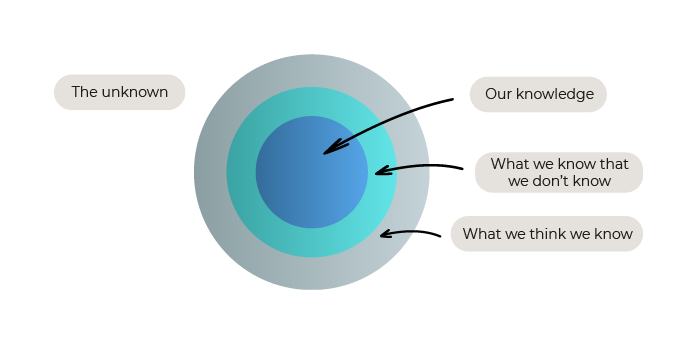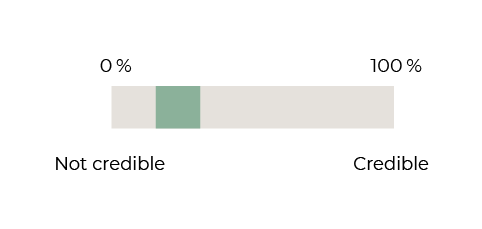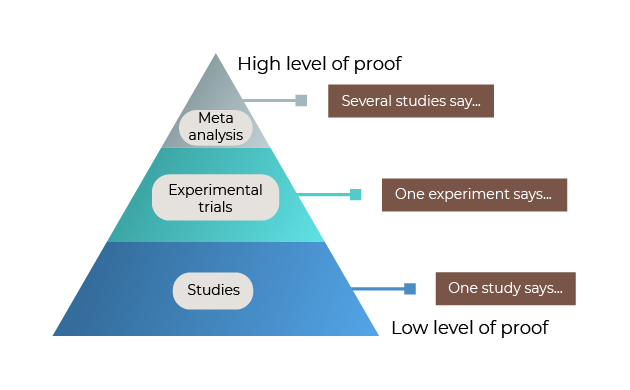Did you know that you have a blind spot? To learn about it, try a small experiment.

Copy the above diagram onto a blank sheet of paper. The cross and the spot should be about 10 centimeters apart (3 to 4 inches).
Hold the sheet about forty centimeters away from you, at eye level.
Close your left eye and look directly at the cross with your right eye.
Now move your head forwards, slowly.
What do you notice? After a while, the spot disappears. This is the moment when the image of the spot passes through the area of your right eye, known as the blind spot, where the optic nerve enters the retina, and there are no visual receptors. If you continue to move your head forward, the circle reappears.
Your brain knows that there is a black spot, but you don't necessarily see it. It's the same with cognitive biases. You now know that they are there, but you don't see them. In other words, the only effective way to fight against them is to accept their existence, to learn to notice them and make your decisions more objective.
Assess How Much You Trust Your Knowledge
Distinguish Between the Different Categories of Knowledge
Over the centuries, human knowledge has continued to develop. However, there remain a lot of unanswered questions.
Imagine that humanity's knowledge is spherical, surrounded by all the unknown things. The contact area between what is known and what is unknown grows as we make scientific and philosophical discoveries.

Let's examine four categories of knowledge (in order of size):
Our knowledge: what we know.
What we know that we don't know.
What we think we know.
The unknown: what we don't know that we don't know.
We only find out "what we know that we don't know" when the knowledge moves from "what we think we know" to "what we know."
Use the Credibility Gauge
A credibility gauge is a tool that can help question your knowledge. It helps define the level of certainty and evidence required to validate or invalidate that knowledge.

This gauge can never be at 0% or 100% because knowledge grows, and certainty is only valid until you question it.
Nia’s Interview
We asked Nia Cason how to use the scientific method when researching a new topic and getting closer to the truth. In the interview below, she shares her experience and provides tips on how to apply the scientific method in a professional context:
It's Your Turn

Set your credibility gauge for the following statements:
Cold water always freezes faster than warm water.
Diving tanks are full of oxygen.
Light attracts mosquitoes.
Chili con carne is a Mexican dish.
Are you finished?
All four statements are false! However, they seem to make sense or are widely held truths.
Do you still need to be convinced? Here is the proof:
An article from the website Livescience "Does Hot Water Freeze Faster Than Cold Water?" demonstrates that the statement is not true.
Aqua Views, an online scuba diving magazine, explains that diving tanks never contain pure oxygen in this article.
The website Pest Strategies shows that mosquitos are not attracted to light in an online guide.
A cooking blog "What's Cooking America" explains in a Chili recipe that chili con carne originated in Texas.
Gather Evidence
Have you heard of flat-earthers? They are a community of people convinced that the earth is flat. They even have experts (possibly a bit skewed). These people are not the victims of some psychiatric pathology. If you are on a tiny island, isolated in the middle of the ocean, what you see around you is flat. Your senses and your personal experience show that you are on a flat surface.
I believe that the earth is round, although I have never seen it.
How do I know? I trust researchers who are backed by what I consider sufficient evidence. Then I discovered that the visible universe's observable planets are all more or less round (slightly flattened at the poles). There is a consensus about round planets, which supports my belief that the earth is spherical. While my senses tell me otherwise, I still have my opinion (even without independent research). It has become knowledge: a belief backed up by evidence that has convinced me.
Evidence establishes that something is true and provides a convincing example. But does all evidence carry the same weight? Not really!
This pyramid is a simplified version of the evidence-based medicine (EBM) pyramid, widely used to determine the quality of medical research:

If you had to list levels of evidence from the lowest quality to the highest, this is what you might find:
Personal experience (maybe evidence but with a low quality level).
The opinion of experts who have a great deal of knowledge on a particular subject.
Scientific studies conducted in isolation, even though they have a reliable protocol.
Single-subject studies that arrive at a consensus when most of the researchers agree.
Let's look at how to put evidence into practice using topics from the business world.
It's Your Turn: Test Your Skepticism!

This third section aims to look at the effects of cognitive biases as they relate to corporate decision-making. Try to highlight the errors and potentially incorrect choices in both individual and collective decisions.
Analyze the following situation. What biases and errors affect the judgment of the characters?
R. is a brilliant manager. He has proven himself in two major U.S. sales companies. One of them (in tech) now has one of the world’s largest stock values. A sales concept he invented has played a significant part in this company’s success.
In 2011, another company (in the sales sector) poached him. He received $52.7 million when he joined the chain of stores. He simultaneously invested $50 million back into the company. Strengthened by his previous successes, he embraced the CEO role and its mission to shake up the store’s image and attract new customers. His approach, based on recognized marketing concepts, was radical and involved a significant transformation of commercial operations:
Massively reducing distributor brands to offer famous national brands.
Replacing cash registers with mobile employees equipped with a tablet to facilitate the purchase as close as possible to the product.
Replacing discounts and coupons with everyday prices that were more clear and equitable.
Repositioning the stores downtown (over 100 new stores for a country-wide presence).
Laying off 20% of non-essential employees.
The results were catastrophic. During 2012, sales fell by over 30%. When the board of directors ousted the CEO in April 2013, it was already too late. The company had already lost the trust of the shareholders and customers. In April 2020, after failing to redress the situation, the company considered going into liquidation. Faced with serious problems, the lockdown measures linked to the COVID-19 pandemic may force the company to close all of its 850 stores and lay off most of the 95,000 employees.
Analysis and Conclusion
Lots of biases could explain the collapse of the company. One of the main ones seems to be the survivor bias. The company failed to consider that R.'s success was probably based on many factors, beginning with his previous company's target market and products, plus his talents as a director.
Let's Recap!
In this chapter, you learned that:
Knowledge is always limited, and that you must stay humble even with certainty. You should also remain curious about what could be uncovered next.
You can use the credibility gauge to assess your current position on a topic critically.
If you use the evidence pyramid alongside the credibility gauge, you have a more accurate picture of the quality of evidence when evaluating your position.
Practicing your analytical skills on work-related issues can help you make sense of these tools and avoid critical mistakes.
The dictum attributed (perhaps incorrectly) to Seneca: “Errare humanum est, perseverare diabolicum” means that people learn from their mistakes. You have to question yourself. But who can you trust if everyone gets it wrong? Find out in the next chapter!
